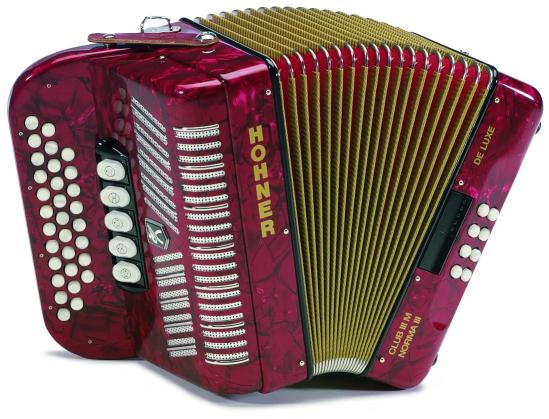This is the of You won't see this message or any elements not part of the book's content when you print or this page. Preface [ ] The accordion is a portable box-shaped musical instrument of the hand-held bellows-driven free-reed aerophone family, colloquially referred to as a squeezebox. A person who plays the accordion is called an accordionist.
The instrument is played by compressing or expanding its bellows, while pressing buttons or keys, causing valves called pallets to open which allow air to flow across strips of metal called reeds that vibrate to produce sound inside the body, which then escapes through grilles. There are three major types of accordion: the diatonic button accordion, the chromatic button accordion (sometimes called a bayan), and the unisoric chromatic piano accordion. Although the accordion has a reputation in some circles of being cheap, wheezy instruments capable of playing only polkas and folk music, this is not always the case! A full-sized, properly-maintained accordion in the right hands can play almost any type of music, ranging from classical music like Bach and Chopin all the way to jazz and pop, and quite convincingly too.
This German style push-pull diatonic accordion. This button accordion features greater. Includes 40-page instruction book; Hohner Piano Accordions. Falls in 1998 when I started learning to play, and there was nobody around who even played a piano accordion, let alone a diatonic box. I had no choice but to learn by myself. Learning to play accordion without a teacher sounds like a daunting task, but it really is not.


Indeed, many European conservatories and universities regard it as a serious concert instrument, and allow it to be studied at the same level as a piano or string instrument. This book is currently only about playing the Piano Accordion, although there are many similarities in function to similar instruments, so playing skills such as Bellows, Stradella Bass and Register Switches will transfer to other instruments. Not all parts will be introduced at first, only sufficient to get you started playing tunes. Percy jackson and the lightning thief script pdf the best free software for your.
A piano accordion The piano accordion is the instrument most often indicated by the term 'accordion', but it is one of the most recent inventions among accordion types, appearing late in the 19th century and not accepted worldwide until the early 20th century. It has a right-hand keyboard similar to a piano. This is great news for you if you ever took piano lessons! 2 anime download sims skin textures. The left hand keyboard is usually configured in the Stradella system, a combination of chords and single notes, arranged in a uniform series by harmonic relationship. This is the system we'll be focusing on throughout this book.
Occasionally, a free bass left hand is used, which has a series of single buttons in an arrangement similar to the chromatic button accordion. The free bass system facilitates the playing of bass melodies and counterpoint over a melodic span greater than one octave. It also allows for chord inversion and invention of chords not present in the Stradella system, although the Stradella system also allows creation of extra chords and inversions using simultaneous multiple chord buttons. Converter bass systems allow an instrument to be readily converted from a Stradella system to a free-bass system with a switch.
How to hold the accordion standing up. Since your left arm is moving horizontally and vertically, and your right hand is moving vertically, body position is very important. The main goal is to be comfortable yet exercise as much control as possible over the motions of the instrument. Some players prefer sitting, while others like to stand (although this can be easily tiring, especially with a big instrument). When playing the accordion, the shoulder straps should be fairly tight so that the instrument doesn't shift around as you reach for notes. Don't slouch - it looks ugly and causes you to lose control. Your left arm should be between the bellow-strap and the board; tighten that strap (usually via a notch on top of the bellows mechanism, very rarely Velcro might be used) so that it won't cut off your arm circulation, but not so loose that your hand slips as you change directions with the bellows.
Resist the temptation to bend your right wrist and play with your elbow close to the side of your body. Instead, try to hold your entire arm, from the elbow to the wrist, more or less parallel with the keyboard. Though this may seem awkward at first, in the long run it will help you achieve better accuracy because the circulation to your hand is unimpeded. Note that none of this applies to the left arm. If playing standing up, stand with good posture and adjust the shoulder straps so that the bottom of the accordion is more or less parallel with the floor and the back of the keyboard portion is against your chest. This will help keep it from shifting too much while you play. If playing seated, adjust the straps so that the instrument rests lightly on your left leg but doesn't hang loosely from your body.
Recent Pages
- Driver Mouse Optico Maxprint
- The Steve Harvey Show Torrents
- Programmu Dlya Proshivki Zte S300 S325
- Blackmagic Forair 16 Crack
- Contoh Perjanjian Sewa Menyewa Rumah Pdf File
- Download Update Patch Winning Eleven 8 Musim 2015 Terbaru Berita
- Download Boardmaker V6 Crack
- Stm Bengali Typing Software Crack Version Of Microsoft
- Blank Licevaya Kartochka Avtomobilya
- Mister Retro Keygen Mac Crack
- Silent Hill Homecoming Savegame Pc Richards
- Ir Saptar Tuulgan Kungo Kuttuktoolor
- Gcc Sable 60 Driver Windows 10
- Garbha Raksha Mantra Mp3 Songs
- Savage Arms Model 72 Serial Number Lookup